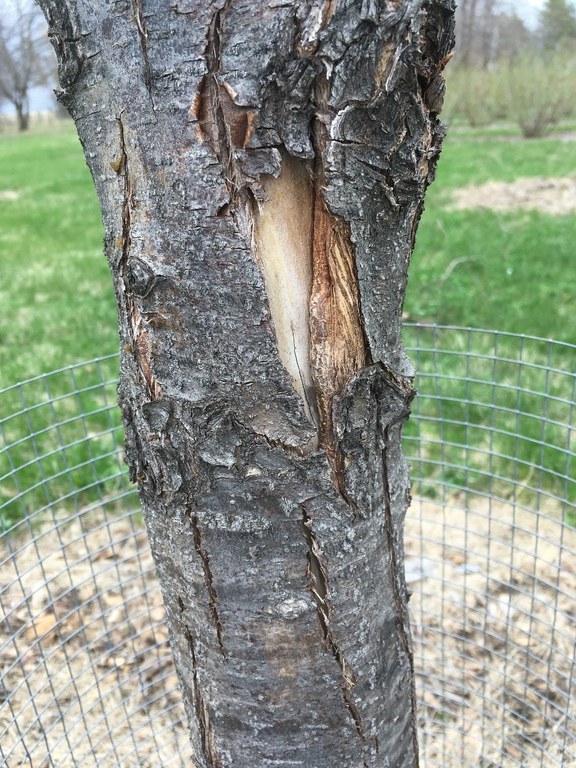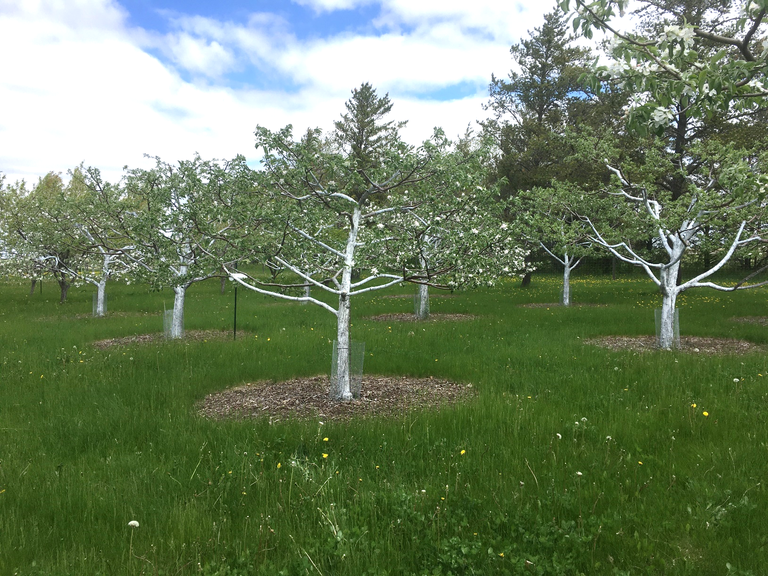Sunscald in Fruit Trees
We may have appreciated the warm days in March, but in our cold climate, I am afraid we may see sunscald damage this year in trees with thin bark, like fruit, mountain ash and maple trees. The NDAWN data https://ndawn.ndsu.nodak.edu/ shows that in March, we saw 10 days where the temperature swings were 35oF or more with warm days followed by very cold nights. These conditions can lead to sunscald.
Sunscald injures the growth tissue (the cambium) behind the bark of the trunk in winter. You will notice sunscald as an elongated area of dead bark on the south or southwest sides of tree trunks or branches that slope toward the afternoon sun. At first, the area will look sunken with dried, cracked bark. Later, the bark peels off to expose dead wood. Young trees and trees with thin bark, like fruit trees, are more susceptible to sunscald.

Sunscald injury on Pear – several years old when discovered.
On sunny, cold days, the dark tree bark absorbs the sun’s energy and warms up. This “de-acclimates” the area and it becomes less able to withstand freezing temperatures. At night, the temperatures fall and this area is not able to withstand the effects of freezing. You may not see the damage for several years as it takes time for the bark become dry and then fall away as the healing tissues grow underneath to cover the wound.
If the damage is not too large, a callus will close the wound over several years. But in the meantime, this area is susceptible to fungi and insects. Several years ago, I had to remove a weeping ‘Hazen’ apple tree branch that became infected with black rot after sunscald damage. After you notice the problem, help the area heal by carefully removing dead and loose bark that could be a home for insects or moisture. DO NOT treat the wound with any ‘wound dressing’ or paint. It is best to let it heal naturally.
 South and SW sides of trunk and larger branches sprayed with 50:50 white latex paint.
South and SW sides of trunk and larger branches sprayed with 50:50 white latex paint.
To prevent sunscald injuries in the future, you need to prevent the bark from heating up.
- Leave lower branches on the south and southwest sides of young tree trunks to provide trunk shade.
- In fall, you can tie a board on the southwest side of the trunk for shade.
- Light-colored, loose tree wraps reflect light and can help. Removed as soon as possible in spring to prevent damp conditions inside the wrap.
- Or, paint exposed trunks and lower limbs on the south and southwest sides with white latex paint to reflect sunlight and keep the bark cool. This is the easiest method and lasts several years but if it is too ugly for you, go with one of the other methods.
FS197E ENVIRONMENTAL INJURY: SUNSCALD AND SUNBURN ON TREES
Washington State University Extension
By Marianne C. Ophardt, WSU Extension Area Horticulture Specialist.
Rita L. Hummel, Ph.D., Horticulture, WSU Puyallup Research and Extension Center
https://bit.ly/3a7TEcM
Kathy Wiederholt
Kathy.Wiederholt@ndsu.edu
Fruit Project Manager


